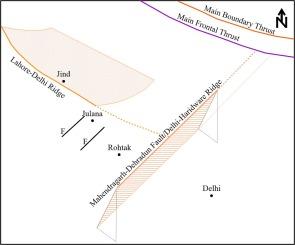印度西北部地震活跃的 Jind-Rohtak-Delhi 地区山脊-断层结构的电结构:磁电研究成像
IF 2.7
3区 地球科学
Q2 GEOSCIENCES, MULTIDISCIPLINARY
引用次数: 0
摘要
德里地区是印度-亚洲碰撞过程中主要的地震活跃地区。因此,我们在穿越 Jind-Rohtak 地区的 NW-SE 剖面上的 11 个台站进行了宽带磁测(MT)研究。阻抗张量的旋转显示了 N8oW 的区域走向角,相位张量响应近似于二维结构。因此,利用二维非线性共轭梯度算法,从 TE 和 TM 模式联合数据中获得了地壳电结构。结果表明,整个剖面下有厚度为 300 米的沉积层,其导电率为 1 Ω-m,在地壳上部发现了与地表导电层相连的导体 C2。导体 C1 和 C3 分别是与拉合尔-德里海脊(LDR)和德里-哈里瓦尔海脊(DHR)相关的地壳特征。与德里-哈里德瓦尔海脊平行的 NNE-SSW 走向的马亨德拉加尔-德勒敦断层(MDF)呈西北倾角。高电导率证明了下地壳中蛇纹石矿物的来源。我们推断,在研究区域的下地壳中,这两条山脊可能是相连的,并表明这是一个三重交界处。该断层带在构造上与喜马拉雅弧有关,该地区的地震发生是由于俯冲过程中深层热量的移动。表层导电层是更新世时期的冲积物(淤泥和粘土),导体被解释为部分熔体或流体通过路径向上迁移。本文章由计算机程序翻译,如有差异,请以英文原文为准。

Electrical architecture across the Ridge-Fault structure in the seismically active Jind-Rohtak-Delhi regions, NW India: Imaged from magnetotellurics studies
The Delhi region is principally seismically active in the process of the India-Asia collision. Therefore, broadband Magnetotelluric (MT) studies were carried out at 11 stations along NW-SE profile passing through Jind-Rohtak regions. The rotation of the impedance tensor showed a regional strike angle of N8oW, and phase tensor response approximate the 2-D structure. Therefore, electrical crustal structure was obtained from joint TE- and TM-modes data using a 2-D nonlinear conjugate gradient algorithm. The outcomes showed a ∼300 m thick sediments layer with conductivity ∼1 Ω-m beneath the entire profile, and conductor C2 revealed in the upper crust that joins the surface conductive layer. The conductors C1 and C3 are crustal features associated with Lahore-Delhi Ridge (LDR) and Delhi-Haridwar Ridge (DHR), respectively. The NNE-SSW trending Mahendragarh-Dehradun Fault (MDF) parallel to the DHR is suggested northwest dipping. The high conductivity supports the source of serpentine minerals in the lower crust. Our inference that the two ridges may be connected in the lower crust in the study region, and suggesting a triple junction. The fault zone tectonically associated with Himalayan arc, seismicity in the region occurs due to the movement of deep-seated heat in the process subduction. The surface conductive layer is attributed to Pleistocene age alluvium materials (silts and clays), and conductors are interpreted the partial melt or fluids that migrate upward through the pathway.
求助全文
通过发布文献求助,成功后即可免费获取论文全文。
去求助
来源期刊

Journal of Asian Earth Sciences
地学-地球科学综合
CiteScore
5.90
自引率
10.00%
发文量
324
审稿时长
71 days
期刊介绍:
Journal of Asian Earth Sciences has an open access mirror journal Journal of Asian Earth Sciences: X, sharing the same aims and scope, editorial team, submission system and rigorous peer review.
The Journal of Asian Earth Sciences is an international interdisciplinary journal devoted to all aspects of research related to the solid Earth Sciences of Asia. The Journal publishes high quality, peer-reviewed scientific papers on the regional geology, tectonics, geochemistry and geophysics of Asia. It will be devoted primarily to research papers but short communications relating to new developments of broad interest, reviews and book reviews will also be included. Papers must have international appeal and should present work of more than local significance.
The scope includes deep processes of the Asian continent and its adjacent oceans; seismology and earthquakes; orogeny, magmatism, metamorphism and volcanism; growth, deformation and destruction of the Asian crust; crust-mantle interaction; evolution of life (early life, biostratigraphy, biogeography and mass-extinction); fluids, fluxes and reservoirs of mineral and energy resources; surface processes (weathering, erosion, transport and deposition of sediments) and resulting geomorphology; and the response of the Earth to global climate change as viewed within the Asian continent and surrounding oceans.
 求助内容:
求助内容: 应助结果提醒方式:
应助结果提醒方式:


